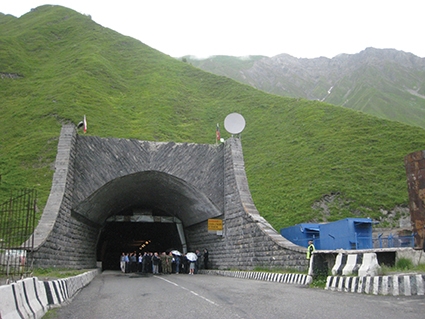Russia Works on Extending its Corridors to the South Caucasus
Russian-Georgian relations have witnessed a number of interesting developments in the recent period. Progress has been made on the issue of opening/controlling trade routes through Georgia’s Abkhazia and South Ossetia breakaway territories, while Russia on July 15 announced that works are starting on the Avaro-Kakhetian road – a 85 km highway which will connect Dagestan with Georgia’s Kakheti region. The numbers of Russian tourists are up and the same trend is observable in bilateral trade contacts between the countries. Yet on July 15, Russia restricted scheduled Tbilisi outbound flights to Moscow citing earlier restrictions imposed by the Georgian government on Russian Ural airways, which itself follows early July developments when Russian troops moved South Ossetia’s makeshift “border” signs some 700 meters deeper south towards Georgia’s east-west highway.
It is hard to contextualize all these moves and developments. Certainly not all of them are of strategic importance. For instance, the issue of shutting down Georgian Airways flights could be seen as temporary, as a “quid pro quo” step by Moscow which can easily be fixed. The opening/controlling of the trade routes is linked to the 2011 agreement and can be hailed as a minor victory for Tbilisi. However, the question of the Avaro-Kahetian road is of more lasting importance, and Moscow’s behavior here is formed by the geography of the Caucasus region and dilemmas emanating from it.
As Russia is located on a vast and flat landmass, the European plain, it has virtually no geographic barriers. In fact, the Ural mountain range could be regarded as such, but even there the average height is little more than 1000 meters and thus does not represent an insurmountable obstruction. This may explain why the Russians have always been fearful of, and in fact subject to, foreign invasions - from the Mongols in the east to the French and Germans in the west. The natural reaction to this was the creation of a strong military force to protect the country’s borders.
The Caucasus Range, though, represents by far the only large geographic barrier the Russians have ever crossed. Russia could well have shut itself behind the mountain range and not have tried to cross into the South Caucasus. But since the decision was made in late XVIII-early XIX centuries by Russia, its rulers have always cared about improving the existing and creating additional routes through said mountains.
Russia could not allow those natural and artificial passes to be under foreign control as it would essentially mean barring Moscow’s projection of power into the region. Currently, Russia has three major routes in: the first from Sochi and the surrounding territories to Abkhazia along the Black Sea coast; the second through the Roki Pass in South Ossetia (Samachablo); and the third along the Caspian Sea coast from Dagestan to Azerbaijan. Russia has consistently dominated the three routes and when threatened, has used military action, much as it did in 2008 when there was a real possibility of the Roki Pass being overtaken by Georgian troops.
The control of the routes allows Russia to quickly deploy its forces in Abkhazia and South Ossetia and, in case of urgency, even threaten Tbilisi. From the Russian perspective, this projection of hard military power, through the three routes, serves the basis of Moscow’s foreign policy whereby the chances of Georgia’s NATO membership are drastically reduced.
The construction of the Avaro-Kakhetian road could be based on the premise of having deeper economic cooperation with Georgia. Trade between the countries has considerably increased in recent years. But there is a military aspect, too, as the road, like the Roki Pass and the Abkhazia route, could be used for military purposes in case of armed escalation. Also arising is the need for an alternative route connecting Russia with Armenia. The Larsi Pass, which is currently used for the transit of Armenian goods and passengers, is difficult to keep open in winter and is often closed, causing problems for Armenia.
Thus, for the Russians, there may be multiple reasons behind building an additional road to the South Caucasus. Further projection of military power and extension of connectivity with the region certainly serves Moscow’s purpose. In addition, the road can be used for better links with Russia’s ally Armenia. In any case, for Tbilisi it is harder to find positive scenarios for the Avaro-Kakhetian road as there have been too many cases in Georgian history when Russian infrastructure projects served more military purposes than the development of the South Caucasus region.
Emil Avdaliani












